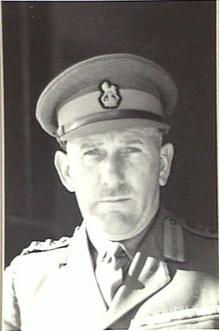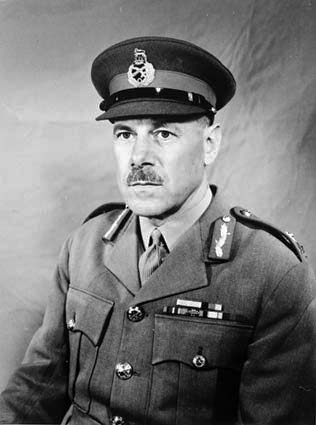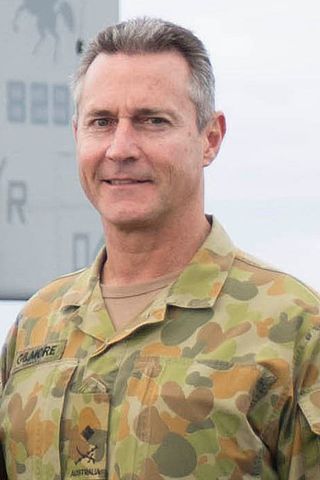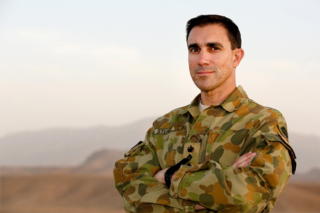Lieutenant General John Murray Sanderson, is a retired senior Australian Army officer and vice-regal representative. He served as Force Commander of the United Nations Transitional Authority in Cambodia from 1992 to 1993, Chief of Army from 1995 to 1998, and was the 29th Governor of Western Australia from 2000 to 2005.

General Sir Francis George Hassett was an Australian general who rose to the position of Chief of the Defence Force Staff, the professional head of the Australian Defence Force, serving in this capacity from November 1975 until April 1977. Hassett joined the Australian Army in 1935 upon gaining entrance into the Royal Military College, Duntroon. Serving with distinction in the early stages of the Second World War, he was promoted to lieutenant colonel in 1942 at the age of 23, and posted as a staff officer for the remainder of the war.

Lieutenant General Sir Reginald George Pollard, was a senior commander in the Australian Army. He served as Chief of the General Staff from 1960 to 1963.

General Sir John Gordon Noel Wilton, was a senior commander in the Australian Army. He served as Chief of the General Staff (CGS), the Army's professional head, from 1963 until 1966, and as Chairman of the Chiefs of Staff Committee (CCOSC), forerunner of the role of Australia's Chief of the Defence Force, from 1966 until 1970. His eight-year tenure as senior officer of first the Army and then the Australian military spanned almost the entire period of the nation's involvement in the Vietnam War.

Lieutenant General Brian Ashley "Ash" Power is a retired senior officer of the Australian Army. Power served as Chief of Joint Operations from 2011 until his retirement in May 2014.

Air Marshal Sir Alister Murray Murdoch, was a senior commander in the Royal Australian Air Force (RAAF). He served as Chief of the Air Staff (CAS) from 1965 to 1969. Joining the Air Force in 1930, Murdoch trained as a seaplane pilot and participated in an Antarctic rescue mission for lost explorers in 1935. During World War II, he commanded No. 221 Squadron RAF in Europe and the Middle East, and later occupied senior positions on the staff of RAAF formations in the South West Pacific. His post-war appointments included Commandant of RAAF College from 1952 to 1953, Air Officer Commanding (AOC) Training Command from 1953 to 1955, Deputy Chief of the Air Staff from 1958 to 1959, and AOC Operational Command from 1962 to 1965.
General Peter Courtney Gration is a retired senior Australian Army officer who served in the positions of Chief of the General Staff (1984–87) and Chief of the Defence Force (1987–93), the professional head of the Australian Army and Australian Defence Force, respectively.

Lieutenant General Sir William Bridgeford, was a senior officer in the Australian Army. He began his military career in 1913 and fought on the Western Front during the First World War, before rising to command the 3rd Infantry Division during the Bougainville campaign in the Second World War. Later he served as the Commander in Chief of British Commonwealth Forces Korea during the Korean War. He retired from the military in 1953 and worked on the organising committee of the 1956 Melbourne Olympic Games, as well as being the director of several companies and treasurer of a returned services organisation.

Lieutenant General Sir Mervyn Francis Brogan, was a senior officer in the Australian Army who served as Chief of the General Staff from 1971 to 1973.

Lieutenant General John Graham Caligari, is a retired senior officer of the Australian Army. He served as Chief Capability Development Group from October 2014 until his retirement in August 2015.
Major General Ian Campbell Gordon, is a retired senior officer of the Australian Army. He had a long and distinguished career culminating as Deputy Chief of Army (2004–2006) and Chief of Staff of the United Nations Truce Supervision Organization (2006–2008).

Major General Peter Warwick "Gus" Gilmore, is a retired senior officer of the Australian Army. A graduate of the Royal Military College, Duntroon, he was commissioned into the Royal Australian Infantry Corps in 1983 and spent much of his career in special forces. He commanded the Special Air Service Regiment (2001–02), led the first contingent of the Australian Special Operations Task Group in Afghanistan (2001–02), was responsible for the Coalition Advisory Support Team in Iraq (2005–06), and commanded International Security Assistance Force Special Operations Forces (2009–10). Following promotion to major general he held a succession of senior appointments, including Special Operations Commander Australia (2011–13), Deputy Chief of Army (2013–15), and Commander Forces Command (2015–16). His final appointment was as Head Military Strategic Commitments Division from 2016 to 2019.

Lieutenant General Richard Maxwell "Rick" Burr, is a retired senior officer of the Australian Army, who served as Chief of Army from 2 July 2018 to 1 July 2022. He was previously Commander 1st Division from 2011 to 2012, Deputy Commanding General – Operations, United States Army Pacific from January 2013 to November 2014, and Deputy Chief of Army from 2015 to 2018.

Major General Ronald Laurence Hughes, was a senior infantry officer in the Australian Army, seeing service during the Second World War, the Korean War and the Vietnam War. Joining the Australian Army in 1937, after graduating from the Royal Military College, Duntroon in 1939 he served in New Guinea and Borneo during the Second World War. He commanded the 3rd Battalion, Royal Australian Regiment during the static phase of the war in Korea in 1952–1953. Later, he commanded the 1st Australian Task Force in South Vietnam in 1967–68, during some of the heaviest fighting of the war experienced by the Australians. He subsequently filled a number of senior command and staff positions before retiring in 1977.

Lieutenant General Gregory Charles Bilton, is a senior officer in the Australian Army. He was seconded to the United States Army Pacific as Deputy Commanding General – Operations from 2014 to 2017, served as Deputy Chief of Joint Operations from 2017 to 2018, and was Commander Forces Command from December 2018 to June 2019. He assumed his current appointment as Chief of Joint Operations on 1 July 2019.
Lieutenant General Hector Geoffrey Edgar, was a senior officer in the Australian Army. He graduated from the Royal Military College, Duntroon in 1923, and occupied a series of staff positions prior to and during the Second World War. Involved in the planning for the Long Range Weapons Establishment in the late 1940s, he served as Deputy Chief of the General Staff (1954–58), General Officer Commanding (GOC) Southern Command (1958–60), and GOC Eastern Command (1960–63).
Major General Jeffery John Sengelman, is a retired senior officer of the Australian Army. He joined the army via the Officer Cadet School, Portsea in 1980, was commissioned into the Royal Australian Infantry Corps and spent much of his military career in special forces. He commanded the 4th Battalion, Royal Australian Regiment (Commando) (2000–01) and the 6th Brigade (2010–11), deployed on operations to East Timor and Iraq, and served as Commander Forces Command in 2011, Deputy Chief of Army from 2011 to 2012, Head of Modernisation and Strategic Planning – Army from 2012 to 2014, and Special Operations Commander Australia from 2014 until his retirement in 2017.

Major General Justin Frederick Ellwood,, commonly known as Jake Ellwood, is a retired senior officer of the Australian Army. He joined the army via the Royal Military College, Duntroon in 1989 and was commissioned into the Royal Australian Infantry Corps. He commanded the 5th Battalion, Royal Australian Regiment (2006–08), Overwatch Battle Group (West) (2007), Battle Group Tiger (2008) and the Combat Training Centre, and deployed on operations to Kosovo, East Timor, Iraq and Afghanistan. He served as Deputy Chief of Army from May to December 2018, and commanded the 1st Division from December 2018 to November 2021.

Lieutenant General Simon Andrew Stuart, is a senior officer of the Australian Army who has served as the Chief of Army since July 2022. He was commissioned into the Royal Australian Infantry Corps from the Royal Military College, Duntroon in 1990. He has commanded the 8th/9th Battalion, Royal Australian Regiment (2008–10), Joint Task Force 631 (2010) and Combined Team Uruzgan (2012–13), and deployed to East Timor as part of Operations Warden, Tanager and Astute and to Afghanistan and the Sinai Peninsula. He was Force Commander, Multinational Force and Observers in the Sinai from 2017 to 2019, and Head Land Capability from 2020 to 2022. He succeeded Lieutenant General Rick Burr as Chief of Army on 2 July 2022.
Major General Brian Robert Dawson, is an Australian museum administrator and a retired senior officer of the Australian Army. He joined the army via the Royal Military College, Duntroon in 1973 and was commissioned into the Royal Australian Infantry Corps. He commanded the Base Administrative Support Centre (1995–96), Australian Defence Force Academy (2006–07) and Australian Defence College (2007), deployed on operations to Somalia and the Solomon Islands, and was Deputy Commander Joint Task Force 633 – Iraq from 2007 to 2008. He also served as Director General of Defence Public Affairs (2008–10) and, from 2010 to 2013, was Australia's first Military Representative to NATO and the European Union. Following his retirement from the army, Dawson joined the Australian War Memorial where he has served as Assistant Director, National Collection since December 2017.
















